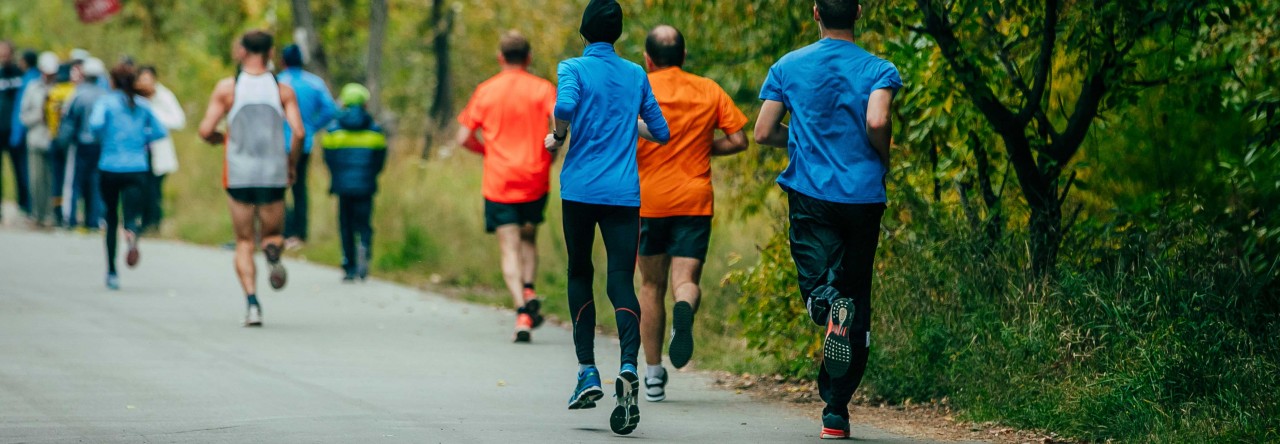I bet you have always heard that running downhills is dangerous because it can injure you and running uphills is safer than all, even safer than running on a flat path. I would say they are some kind of true, especially about uphills. Regarding downhills I know of a way to run it fast and less prone to injury.
Why running downhills is risky?
It is simple, because gravity affects you more [than on flat paths], your speed increases a lot and if you travel too much in the air from one stride to another your impact to the ground will be higher than normal and that might hurt you somewhere in your legs. Getting technical with physics here, the formula is v = g.t in which g is gravity acceleration (varies around the globe between 9.8 – 10 m/s2) and t is the travel time. You should consider this formula on the vertical component of your speed, the one that is made by gravity pulling you down. Clearly, the longer time spent in the air, in a linear way the velocity increases resulting in hitting the ground harder.
If you have understood the above paragraph, to mitigate the risk of injury at running downhills fast, you have to simply minimize the travel time in the air. Decreasing that time would keep you close to the ground to lessen the impact hence the chance of injury; but how?
As mentioned in my previous blog posts I am against some active moves, like active landing, active push-off, or active impose of stride length, etc. This time on running downhills I am not against being active at shortening stride length because at this situation gravity meddles too much with running form so that we have to do something for damage control. Here comes enforcing shorter stride length, allowing for higher cadence (stride rate) to touch the ground more frequently. Easy on paper, tricky at practice, but that is the way to run down safely.
Note that what concerns you in here is the vertical component of that velocity not the horizontal. The horizontal one can increase with no issue and if you do not manage shorter stride length/faster cadence, the vertical component will go up too. Recap, simulate wheel by touching the ground more often to lessen the pressure at landing and allow the horizontal/forward speed roll you down as fast as possible. Mainly your lower legs move; each leg in turn beds at the knee, hamstrings pull a little, unfold the knee quickly to bring the lifted foot back to the ground, otherwise you will travel longer in the air by holding that foot up.
Is it that easy?
Not at the beginning but I assure you, once you learn it you will automatically switch to short stride length mode to run down any hills, even short ones.
No need to mention that on top of theory must come enough practice to master the whole thing. You should practice it when you are fresh (start of a running workout) as well as while being tired (towards the end of a running workout).
I can share a few notes to bear in mind to be able to perform this method correctly.
- Make sure you do not push off the ground at all or what I am saying here will be useless. Pushing off the ground on downhills opposes the strategy of staying close to the ground. Read my previous posts on what it is and how to switch it off.
- Activate your core and gluetus maximus (butt muscles). It is my own anecdote that squeezing tommy and gluetus maximum helps this technique a lot. The reason is, in my opinion from my own experience, this technique is mainly impleneted with lower legs due to the small range of movements required. So when only lower legs move much, upper parts of legs are pretty much for stablization and to provide a base for lower legs to move in the way required. This stablization demands gluets to hold and core to keep the turso affixed to hips.
- Lean backwards to slow down and forward to speed up. Well, this is the same as what I would say for running on any surface using gravity (falling forward) to move on, but you may still keep that fall angle on entering the descending slope and end up in a high speed too quickly. Make sure you control it by slightly leaning backwards initially, then increase it as you feel confident. Remember your falling angle is your accelerator pedal.
- This is a side note to the technique but is as important. Control your breathing on downhills. This is my own anecdotes again. There seems to be a direct connection between brain and eyes and other receptors that acts unconciously to incresae heart and breathing rate from perception of speed. Running downhills is usually faster than what we can manage by our pure effort on other surfances; this running downhills either causes excitement or our body prepares for taking more oxygen to our muscles by increasing heart and breathing rate due to apparent increase of speed, perhaps effort. Whatever it is, it is not necessary and a misperception. You are using less energy to go down a hill, and the only handle you have to control these two rates is your breathing one. Slower and deeper breathing always helps with slower heart rate. So look at it, you go faster while your cardiovascular system rests, is not that amazing?!
Hope this helps you run downhills better. I personally work on this technique a lot, somehow more than or at least equal to the time and effort I put on running uphills because it can actually save you more time during running races. Runners usually maintain the same form and rate of pounding the ground whereas they must, IMHO, switch between different techniques. Practice it on bumps on some roads if there are any around your usual running courses. Go up the bump and switch to quick and short strides on the way down. Turn around and do it again.
Good luck, any questions please email me on rez@progressiverunning.com or use the contact form.


